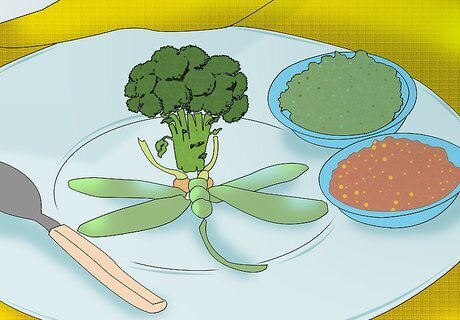
views
Using Common Tricks To Get Your Baby To Eat Vegetables

Start feeding vegetables early on. As soon as your doctor recommends feeding solid foods start incorporating vegetables. This will help acclimate your child to the different flavors. With luck, you may find that your child likes vegetables before he learns to throw his plate.

Give your baby vegetables frequently regardless of their reaction. If a baby isn't used to the way something tastes, they may spit it out or throw it. Even if they have a negative reaction, don't give up. Continue offering different vegetables at each meal—with repeated exposure, they'll be more likely to learn to like the foods later on. Give your baby less vegetables when you anticipate a negative reaction. If he decides to throw his plate or food, you will have more to spare. Only put fresh vegetables onto his plate. If the vegetables are on the floor, throw those away.

Sneak vegetables into meal times. If you are still at the spoon feeding phase you can sneak vegetables into the meal. A couple spoonfuls of something tasty and then a random spoonful of vegetables. He may not like that bite, but you are getting him used to the vegetables. Try hiding veggies in foods like muffins, cereal, rice, and spaghetti sauce. However, be sure to offer the whole veggies as well, so your baby will learn to like them.

Establish a mealtime routine. This helps for babies, and continues to be effective as your baby grows older. Have a routine during which everyone sits down to eat for a period of time. No body gets up until the meal is over. If your baby chooses not to eat then he sits there with a plate of food until the meal is over. This is more effective with older babies. Younger babies may not understand a mealtime routine and become very anxious and upset if forced to sit without stimulation for long. Consider the age and understanding if your baby when you decide to enforce the routine.

Limit snacks to make eating vegetables more rewarding. If your baby snacks all day, they'll be full at mealtime, and they won't be as interested in eating vegetables. When they're hungry, they'll feel satisfaction when eating vegetables. They'll start feeling their hunger go away as soon as they eat. This self-rewarding feeling can be very beneficial to encouraging your baby to eat vegetables.

Dress vegetables up to be fun. Try making mealtime less about a power struggle and more about imagination. If your baby will not eat broccoli, try telling him they are little trees. Build structures or faces on his plate. Tell him he is eating the snowman's nose rather than a carrot.

Show your baby that the vegetables are good. This is as simple as eating them yourself. Most of what a baby learns he learns by replicating others. If you eat the same or similar vegetables as you are feeding him then he may be more interested in eating them. This can be difficult if you have other household members who refuse to eat their vegetables. Try to have everyone pitch in to show your baby everyone is eating the same vegetables he is.

Change up your vegetables. Don't try to feed him the same thing every day until he eats it. Try a different vegetable with each meal. He may like different brands of vegetables more than others. You may also want to try preparing them different ways such as cooked or raw. Be careful not to mix processed vegetables in on a regular basis. Keep a close eye on the nutritional content of the vegetables you use to ensure your baby is not getting too much sodium, fats, or sugars.

Use stories to encourage your baby to eat vegetables. If you like to read to your baby, try reading stories that encourage healthy habits. Kid's shows on television may also be a great way to stimulate your baby to emulate favorite characters. Chose stories that emphasize a certain vegetable. Then incorporate that vegetable into a meal. Be careful with television shows and kids' movies. Although some encourage kids to eat vegetables, others may commiserate with the child. Poor choices of stories may actually discourage eating vegetables. Preview whatever you choose to show your baby.

Hide vegetables in tasty meals or treats. Even as adults, people refuse to eat certain vegetables. Many people may only eat sweet peas when they are in pot pie. Others may avoid lima beans unless they are mixed into a stew. Likewise, hiding vegetables in your baby's food may help encourage them to eat vegetables without them knowing it. Consider a fruit and vegetable smoothie as a treat for you baby. He will likely have no idea what vegetables are in it unless you tell him. Make it right and he'll love it. Try mixing various fruits together with one or two vegetables so the vegetables' tastes are hidden.
Using Reinforcement to Encourage Eating Vegetables

Start by feeding your baby single bites. Vegetables are often bitter. It may take some time for him to get used to the taste. Tell him "Just one bite" and get him used to trying them. You may even find at this point that he favors some vegetables over others.

Smile and laugh with your baby. Eating should be a fun experience. Don't let your frustration come out. He needs to see that even vegetables can be fun. At this stage of development, he needs a lot of positive attention. Be sure to compliment him when he tries or eats his vegetables.

Serve vegetables and fruits together. Your baby will likely love his fruits. When something he likes (i.e., fruits) is served beside something he dislikes (i.e., vegetables) he will, over time, develop more positive feelings about the vegetables. This is very subtle and will take time to occur. Over time he will be more likely to eat that vegetable.

Feed your baby larger amounts of vegetables. As you familiarize him with the tastes, move beyond just one bite. Start giving him larger portions. The goal now is to get him to eat rather than simply taste. Don't reward him with smiles and praise as often for a single bite. Make him work harder for his reward.

Reward your baby after he eats his vegetables. When he eats all of his vegetables, reward him with praise or even with foods he likes. For example, you may give him an extra helping of fruit when he finishes his vegetables. A favorite dessert may also be a good motivational tool. For this to be effective it must be consistent and quickly given. As soon as he eats the last bite he should be receiving the reward, if possible. Even before he can talk and communicate he will begin associating vegetables with praise and rewards. Don't reward your child if he does not eat. You may be frustrated that the reward is "wasted" when you do not give it to him and it goes bad. Choose your rewards carefully to avoid this situation.

Practice using various rewards to learn what motivates your baby. You may find that your rewards are not effective all the time. Switch it up and see what else you can motivate him with. Try one different reward per meal to see what works. Keep track of how much your baby likes each reward. Try to save the best rewards for the more disliked vegetables. Add non-food rewards into the mix. Using only food as a reward may encourage your baby to overeat. Stick with healthy foods like fruits for food rewards, but start adding in favorite activities when your baby is old enough to understand.



















Comments
0 comment